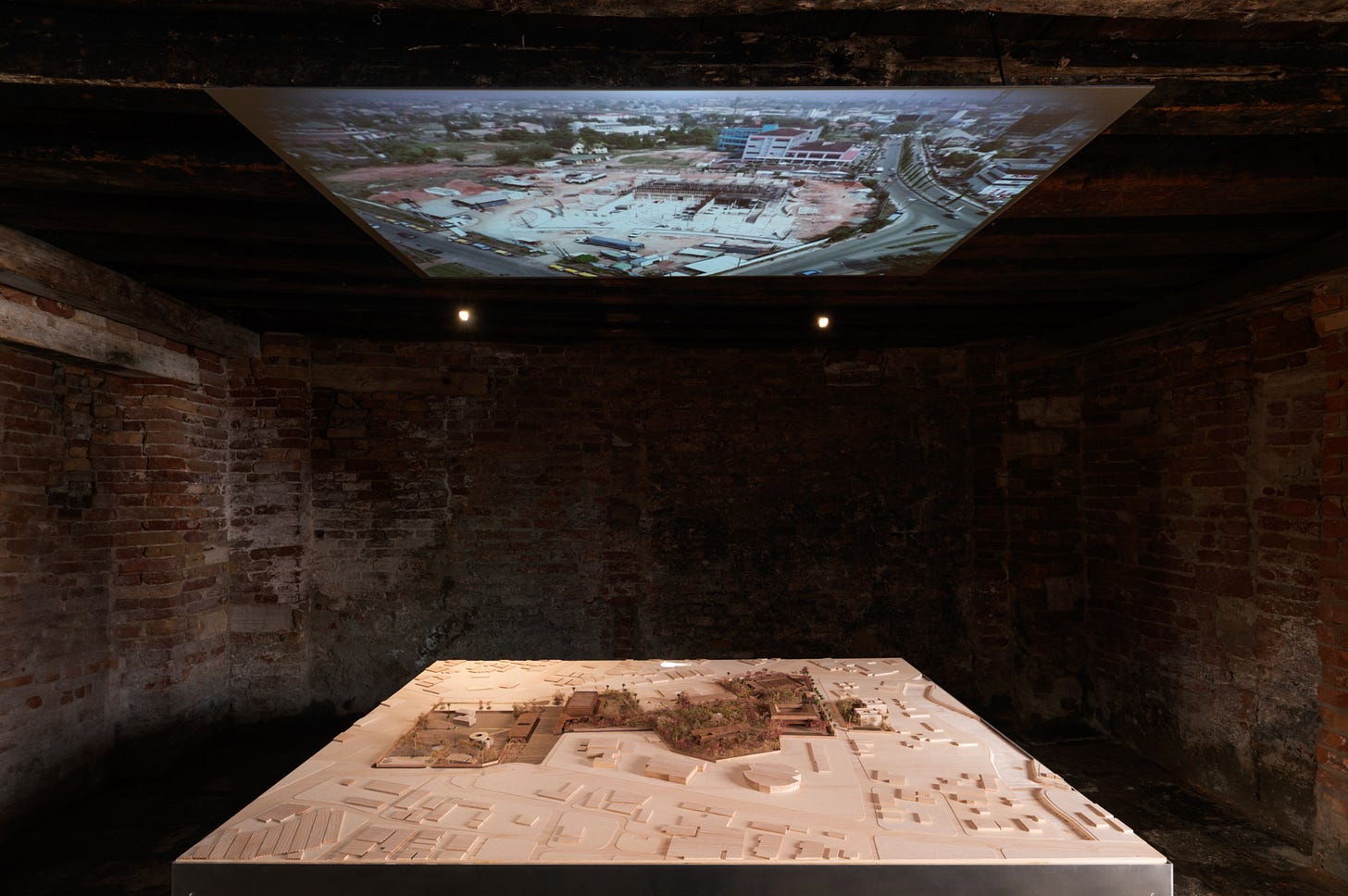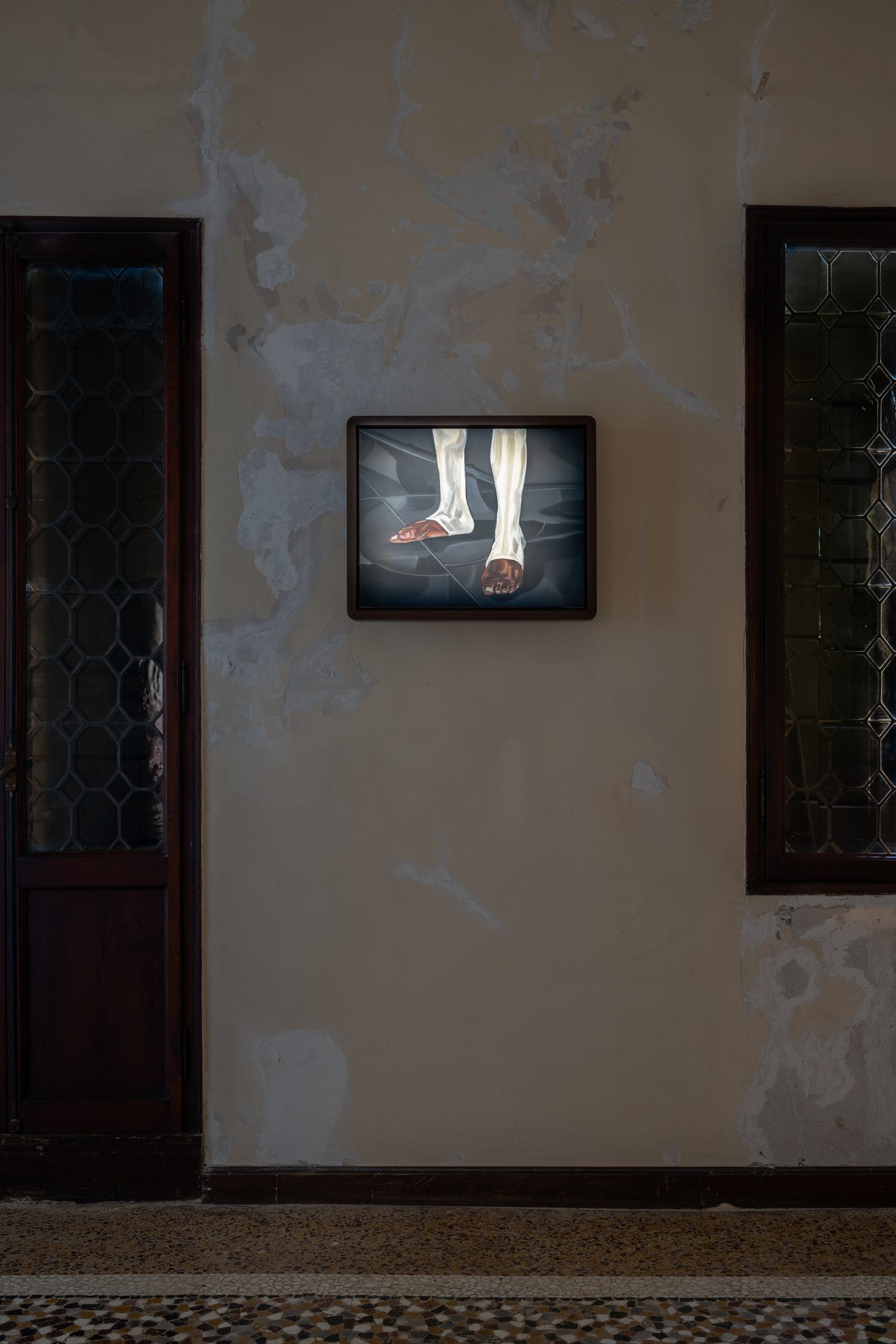Venice Biennale Special: Nigeria Imaginary
Anne Kimunguyi reviews Nigeria Imaginary at the Nigeria Pavilion
One of the larger artworks seen within the site home to the Nigeria Pavilion at the 2024 Venice Biennale is Tunji Adeniyi-Jones’ Celestial Gathering. It is a large-scale painting hung on the ceiling of semi-restored palazzo upstairs room, made up of fiery oranges of light and dark tones. Figures can be made out amidst the swirl of shades, punctuated by their deeper orange colours, floating around a brightly coloured dreamscape. The work is filled with various references to Nigerian and Venetian art history, from images of traditional Yoruba sculpture to Ben Enwonwu’s modernism. It is an, amber, marigold and blood orange infused vision of spirits, a snapshot of a gathering of otherworldly figures whose title incidentally works almost as a metaphor for the curatorial ambition of the Pavilion itself – a meeting point of artistic ideas, brought together for their perceived world-building capabilities, at a juncture in Nigeria’s history.

‘Nigeria Imaginary’ is the title of the Nigeria Pavilion at the 60th anniversary of the Venice Biennale, curated by Aindrea Emelife, the British-Nigerian art historian and curator. Responding to the exhibition’s theme ‘Foreigners Everywhere’ it is a dream-riddled exploration of the histories and cultures that have laid the groundwork for all the possible potentialities of a future Nigeria. Much of the conceptualisation of the show took place during a time of political change in Nigeria, whose recently experienced governmental elections saw greater public debate around imaginings of the country’s future. On the show, Emelife says in her catalogue essay, ‘It explores the role of great moments in Nigeria's history-moments of optimism-as well as the Nigeria that lives in all of our minds: a Nigeria that could be and is yet to be’.
With a focus on the Nigerian diaspora, the exhibition seeks to evoke Nigeria as a state of fluctuation, a site of movement and a place of ever-changing meaning – exterior of the palazzo that opens the show itself is draped with a material inscribed with the words; ‘no condition is permanent’. It is within this ever-shifting space that the displayed works have been brought together to root the country’s past, present and future condition in imagination, globality and art.
Featuring works made from a variety of mediums – film, sculpture, painting, photography, AI and sound, the Nigerian Pavilion features the works of eight artists – Yinka Shonibare CBE RA, Tunji Adeniyi-Jones, Abraham Onoriode Oghobase, Ndidi Dike, Toyin Ojih Odultola, Precious Okoyomon, and Onyeka Igwe.

Onyeka Igwe’s, No Archive can Restore this chorus of (diasporic shame), its title interestingly reframed for this extension of the artist’s existing film work, No Archive can Restore You, is a film-based reimagining of the space that is the derelict Nigerian Film Unit, a British state-run producer of films of the colonial era in Lagos. Igwe fills the shots of the room with poetry, choral music and speeches fill the room, overplayed over the cluttered, dusty space.
In her online introduction, Emelife states:
‘In some ways, the Nigeria Pavilion acts as an Mbari Club: a centre for cultural activity established by African writers, artists, and musicians that was founded in Ibadan, Nigeria (1961) … [who] sought a “laboratory for ideas” in the early years of independence—a site for the paradoxical entanglements of myths, experiences of colonial modernity, moral education, and utopian fantasy. They believed art to be a duty to the nation, a public matter.’
Certainly, Igwe masterfully intertwines ideas of art, public space, and history. Her sonic layering onto the images of the film unit draws from personal archives of sounds collected from various places – Ibadan, Oxford, Bristol, Lagos – and explores the persistent relationship between Great Britain and Nigeria. In turn, Igwe activates the space in a kind of reclamation of history and narrative production.

The imagined Nigeria of this pavilion is not only diasporic, but also global. Ndidi Deke’s two-part work, Blackhood, a Living Archive is made up of a sculptural installation and large-format photographs from the artist’s personal archive. Seven hundred and thirty-six black wooden batons resembling those used by state forces in colonial and post-colonial Nigeria are fitted within a large, black and gridded structure. Symbolic of the victims of racialised violence at the hands of colonial, police and state forces, the batons have brown paper cadaver tags attached, each inscribed with the names of recently deceased Nigerians, African-Americans and Brazilians. This work serves as a devastating commemoration of the victims of state-inflicted Black violence within and beyond Nigeria, reflecting on the Nigerian ENDSARS uprising and the ways in which this resistance threads with movements against police brutality and corruption around the world. Black and white documentary-style photographic portraits - Bearing Witness: Optimism in a Disquiet Present - accompany the structure, reconciling the mass-scale brutality evoked by the sculpted work with the human faces that constitute Blackness, or indeed ‘Blackhood’, in turn surfacing the lives of the communities seeking to string together the fabric for a new Nigeria.

Yinka Shonibare’s sculpted works, entitled – Monument to the Restitution of the Mind and Soul perched along each level of a large pyramid made of red-clay. This is a replica of almost 150 of the Benin Bronzes plundered by a British expeditionary force in 1897, a small percentage of the total objects looted for display in European museums. Including a sculpted head of the leader of this expedition, Sir Harry Ramson, this bust is notably fitted within a vitrine. Art intersects with identity and heritage in this interrogation of dispossession and restitution. In the absence of the latter, Shonibare relies on imagination and creativity to fill the void of physical cultural heritage, and the loss of cultural memory that it abets. In doing so, consideration on the effect and nature of display is surfaced.

Toyin Ojih Odutola’s inclusion in the pavilion is a stunning imaginary scenescape that engages with cultural memory to similarly envision an alternate existence. A series of speculative portraits, equally encouraging the viewer to meet Odutola’s narrative with their own imaginings, their icy white colouring is piercingly illuminated by the room’s lighting. Here, the Mbari house is explored as both a geographical place and an extended metaphor, the accompanying gallery text drawing a direct parallel between the historical club and the intentions of the show. The depictions in Odutola’s works, and the show itself, carve out a ‘portal’ through which guests can witness the theatrical productions of ‘Mbari spirits’, delivered in a ‘hybrid language’ that valorise the contributions of women to Nigeria’s history and imaginary. It is an enchanting imagining of Nigeria that is neither purely alternative, nor strictly fictitious. In Odutola’s works, and indeed, throughout the show, imagination of the future is rooted in the past, the Mbari Club setting the historical precedent for artistic envisioning of a future.
The exhibition is set to tour to the Museum of West African Art, Benin, following its showing in the Biennale, and it is the movement of these works from their current Venice-based platform to Nigerian-based audiences that Emelife has identified as driving the curatorial ambition behind the show. It is connectivity with ‘local audiences’ of the country that will truly allow for a ‘galvanizing’ of Nigeria’s artistic (and political) landscape, as Emelife remarks in her interview for series ten of Shade Podcast. Indeed, if the nation-building efforts attributed to both the works and the exhibition itself are to truly shape the direction of the future, their engagement must extend beyond the industry exclusive, Europe-based, arts showcase that is Venice. Rich in speculative and tangible efforts to connect across history and space, only time and place are left to elevate this gathering of imaginations from an exceptional, parabolic display to the celestial heights of connection and collectivity it deserves.





Thanks so much for this review! I definitely need to check out the conversation with Aindrea Emelife 🙏🏿
🎧🤍✨✨✨ Glad you enjoyed it - I’ll pass that onto Anne. Here’s the conversation https://pod.link/1469562537/episode/5fc5be1e482d800ea6012a36d417b3a5